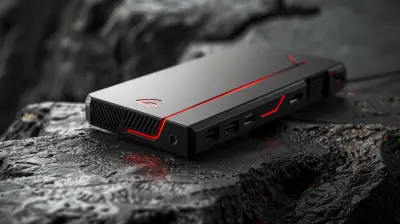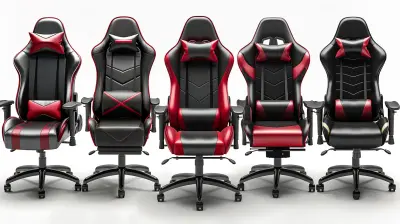11 March 2025
If you’ve ever been deep into a heated first-person shooter (FPS) match—sweat dripping, palms gripping your weapon of choice—you’ve probably wondered: does your input device dictate your gameplay? The long-standing “controller vs. keyboard” debate rages on, with passionate gamers on both sides of the argument. Whether you're team controller or team keyboard and mouse, one thing’s for sure: your choice directly impacts how you perform in FPS games. But how, exactly? Let’s break it down.
The Basics: Controllers and Keyboards
Before diving into the nitty-gritty details, let’s set the stage by examining what each input device brings to the FPS table.What’s the Deal with Controllers?
Controllers are the go-to input device for most console gamers. They’re compact, ergonomic, and designed to fit comfortably in your hands. With tactile buttons and analog sticks, controllers offer a level of familiarity and ease for tons of players.But the real catch here? Analog sticks. These little joysticks allow for smooth, gradual movement—it’s like having precision steering on a car. Need to creep around a corner slowly? No problem. Want to whip your aim across the screen? That’s trickier but doable.
Where Keyboards and Mice Shine
On the other hand, PC gamers swear by their keyboards and mice. Unlike controllers, a mouse offers pinpoint accuracy due to its higher range of sensitivity. You can fine-tune your aim to the tiniest pixel, making quick flicks and precise headshots feel effortless.As for keyboards, they provide a near-limitless range of customization. You’ve got dozens of keys at your disposal for sprinting, crouching, switching weapons, activating skills—you name it. If button-mashing was an art form, a keyboard is the artist’s palette.
So, which one comes out on top? Let’s pit them head-to-head.
Aiming: The Great Divide
When it comes to FPS games, aiming is the bread and butter of any successful match. Let’s dig into how controllers and keyboards differ in this crucial aspect.Controllers: The Aim Assist Savior
If you’re a controller user, you’ve probably heard the term “aim assist” thrown around. Aim assist is a feature designed to give controller players a fighting chance by slightly nudging the crosshair toward nearby enemies. Think of it as a cheat sheet for aiming—it won’t do all the work for you, but it certainly helps.This is particularly critical because analog sticks are, well, less precise than a mouse. Trying to aim with thumbsticks can feel like steering a shopping cart with one bad wheel. Aim assist levels the playing field, ensuring that console players can keep up in mixed matches.
But here’s the thing: aim assist isn’t perfect. Some players argue that it does too much work for you, removing the skill factor. Others feel it’s necessary for controllers to stay competitive against keyboard-and-mouse warriors. Either way, if you’re rocking a controller, aim assist is your not-so-secret weapon.
The Mouse Advantage
Now let’s talk about mice. If aim assist is like a helpful tutor, a mouse is the valedictorian who studied all night. Mice are unmatched when it comes to precision aiming. Thanks to higher DPI (Dots Per Inch) settings, you can adjust sensitivity to your liking and pull off those oh-so-satisfying flick shots.Need to whip around 180 degrees? A quick move of your wrist gets the job done. Want to track an enemy’s head as they sprint across the map? Say no more—the mouse has you covered. This level of precision makes a mouse an absolute beast in FPS games, especially at higher skill levels.
That said, mastering a mouse takes time. It’s not as forgiving as a controller, and without aim assist, every shot relies solely on your skill. But once you’ve got the hang of it, the mouse can feel like an extension of your hand—almost like wielding a scalpel instead of a hammer.
Movement: Freedom vs. Simplicity
Aiming may be the star of the show, but movement plays a huge supporting role. After all, what good is deadly aim if you can’t dodge, strafe, or position yourself effectively?Controllers: Smooth Operators
When it comes to movement, controllers definitely shine. The analog sticks allow you to vary your speed and direction seamlessly. Want to sprint across an open field? Tilt the stick fully forward. Need to tiptoe silently behind an enemy? Just push it slightly. It’s like having a volume knob for your character’s speed.Plus, controllers typically combine movement and aiming into a single compact package. You’ve got everything you need right under your thumbs, making it a convenient choice for casual and competitive players alike.
However, controllers have their limitations. Strafing (moving side-to-side) isn’t as sharp, and if you’re up against a keyboard player, their rapid directional changes might throw you off. Still, for most players, the trade-off is worth it.
Keyboards: The Swiss Army Knife
Keyboard movement is a different beast entirely. Instead of an analog stick, you’re relying on the WASD keys for movement. While this setup lacks the fluidity of a controller, it makes up for it with precision and quick responsiveness. Need to strafe left and right faster than a hyperactive squirrel? WASD gets the job done.Keyboards also let you bind additional movement options to other keys—think crouching, sliding, or even leaning around corners in tactical shooters like Rainbow Six Siege. The level of control feels almost like having superpowers compared to a controller’s relative simplicity.
Skill Gap and Learning Curve
Now, let’s address the elephant in the room: which input method is easier to learn, and which has the higher skill ceiling?The Accessibility of Controllers
Controllers are often regarded as the “plug-and-play” option. They’re intuitive, beginner-friendly, and designed for comfort. You can jump into a game and start playing without needing to worry about customizing key binds or learning complex mechanics.However, this ease of use can come at a cost. Controllers tend to offer a lower skill ceiling compared to keyboards and mice. While you can certainly become a skilled controller player, you might find yourself hitting a wall when facing high-level keyboard-and-mouse players.
The High Ceiling of Keyboard and Mouse
On the flip side, mastering a keyboard and mouse setup isn’t as straightforward. There’s a steeper learning curve, especially if you’re not used to the controls. It might take weeks—or even months—to get comfortable with aiming, movement, and keybinds.But the payoff? Totally worth it. The keyboard and mouse combo offers unparalleled precision and adaptability, making it the preferred choice for professional esports players and hardcore gamers. If you’re willing to put in the effort, the rewards can be game-changing.
The Competitive Scene: Keyboard and Mouse Reigns Supreme
There’s a reason why most competitive FPS tournaments are played on PC with a keyboard and mouse setup. The precision and flexibility provided by this combo give players a distinct edge, especially in high-stakes scenarios where milliseconds matter.That being said, controllers have made their way into the spotlight thanks to crossplay becoming the norm. Some pro players even compete using controllers, relying on aim assist and their honed skills to dominate PC opponents. The lines between the two input methods are blurrier than ever, and that’s what makes the debate so fascinating.
So, Which One Should You Choose?
At the end of the day, the choice between a controller and a keyboard comes down to personal preference. Are you a casual gamer who values comfort and simplicity? A controller is probably your best bet. But if you’re aiming for competitive dominance and don’t mind a steep learning curve, the keyboard and mouse combo is hard to beat.Still on the fence? Why not try both? Many games now support cross-input play, meaning you can switch between devices depending on your mood or the game you’re playing. After all, the ultimate goal is to enjoy the experience—whether you're raining bullets with a controller or landing headshots with a mouse.






Zorina McCaw
Controller wins for precision aiming!
March 27, 2025 at 5:52 AM